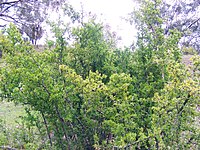
Photo from wikipedia
Goji berries have been used as food and medicine for millennia. Due to their high morphological similarity, fruits of two distinct species belonging to the family Solanaceae, Lycium barbarum (LB)… Click to show full abstract
Goji berries have been used as food and medicine for millennia. Due to their high morphological similarity, fruits of two distinct species belonging to the family Solanaceae, Lycium barbarum (LB) and Lycium chinense (Chinese boxthorn), are usually marketed together as goji berries, but nearly 90% of all commercially available goji berries belong to the former species. A third closely related species, a wild perennial thorny shrub native to north‐western China, Lycium ruthenicum (LR; known as Russian box thorn, and its fruit as black wolfberry), has become a popular choice for combating soil desertification and for alleviating soil salinity/alkalinity due to its high resistance to the harsh environment of saline deserts. Despite the phylogenetic closeness of LB and LR, their fruits are very different. To identify the genes involved in these distinct phenotypes, here we studied expression patterns of 22 transcriptional regulators that may be crucial drivers of these differences during five developmental stages. BAM1 may contribute to higher sugar content in LB. High expression of BFRUCT in ripe LR is likely to be an evolutionary adaptation to fruit ripening in an arid environment. Two arogenate dehydratase paralogues, CHS and LDOX, are probably crucial elements of the mechanism by which LR accumulates much higher levels of anthocyanin. DXS2 (carotenoid accumulation in LB) and CCD4 (carotenoid degradation in ripe LR fruit) may be crucial drivers behind the much higher content of carotenoids in LB. EIL3 and ERF5 are two transcription factors that may contribute to the higher abiotic stress resilience of LR. GATA22‐like appears to have more important roles in growth than ripening in LB fruit and vice versa in LR. HAT5‐like exhibited opposite temporal patterns in two fruits: high in the 1st stage in LB and high in the 5th stage in LR. PED1 was expressed at a much lower level in LR. Finally, we hypothesise that the poorly functionally characterised SCL32 gene may play a part in the increased resistance to environmental stress of LR. We suggest that BAM1, BFRUCT, EIL3, ERF5, ADT paralogues (for functional redundancy), PED1, GATA22‐like, HAT5‐like and SCL32 warrant further functional studies.
Journal Title: FEBS Open Bio
Year Published: 2020
Link to full text (if available)
Share on Social Media: Sign Up to like & get
recommendations!